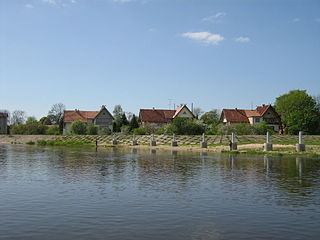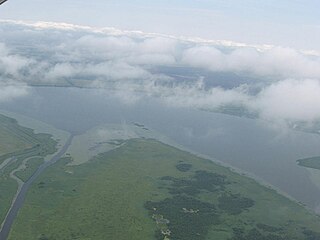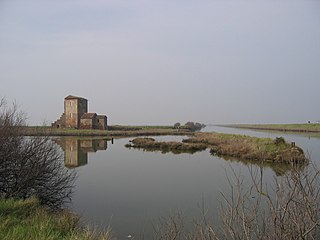Related Research Articles

Camargue is a natural region located south of Arles, France, between the Mediterranean Sea and the two arms of the Rhône delta. The eastern arm is called the Grand Rhône; the western one is the Petit Rhône.

The Nemunas,Nioman, Neman or Memel is a river in Europe that rises in central Belarus and flows through Lithuania then along the northern border of Kaliningrad Oblast, Russia's western exclave which specifically then takes its southern mouth. It drains into its Curonian Lagoon, narrowly connected to the Baltic Sea. It flows about 937 km (582 mi), so it is considered a major Eastern European river. It flows generally west, north, then westward.

The Peace–Athabasca Delta, located in northeast Alberta, is the largest freshwater inland river delta in North America. It is located partially within the southeast corner of Wood Buffalo National Park, Canada's largest national park, and also spreads into the Regional Municipality of Wood Buffalo, west and south of the historical community of Fort Chipewyan. The delta encompasses approximately 321,200 ha, formed where the Peace and Athabasca rivers converge on the Slave River and Lake Athabasca. The delta region is designated a wetland of international importance and a UNESCO World Heritage Site. The region is large enough that it is considered one of twenty distinct natural subregions of Alberta by the provincial government's Natural Regions Committee.

The Gippsland Lakes are a network of lakes, marshes and lagoons in east Gippsland, Victoria, Australia covering an area of about 354 square kilometres (137 sq mi). The largest of the lakes are Lake Wellington, Lake King and Lake Victoria. The lakes are collectively fed by the Avon, Thomson, Latrobe, Mitchell, Nicholson and Tambo rivers.

Šilutė District Municipality is one of 60 municipalities in Lithuania. It is known for spring floods when ice on Nemunas River starts melting. This is the only municipality in Lithuania that gets flooded on regular basis.

Rusnė is a border town in Šilutė district, Lithuania, located on the Rusnė Island in the Nemunas Delta, 9 km south-west from Šilutė.

Ventė Cape, sometimes referred to as Ventė Horn or Ventė Peninsula, is a headland in the Nemunas Delta, in Šilutė district, Lithuania. It is known as a resting place for birds during their migration, particularly in autumn. Ventė Cape Ornithological Station – one of the first bird ringing stations in Europe still in operation – was opened here by Tadas Ivanauskas in 1929.

Rambynas Regional Park is one of the Regional Parks in Lithuania, situated at Pagėgiai municipality on the right Nemunas river bend in Lithuanian Republic near the border of Kaliningrad Oblast. The park was founded in 1992 with its area of 4,786 ha.
... Life is a constant movement. A Wide variety of different forms emerge and disappear... Over the thousand years, stones grow and decay. Life explodes, animals and people are born and so lost... These days, people learn how to look at nature at more calmed glance. And life effects are clearly visible in a strong relationship with nature as if the person opens the whole mystery of nature, all of the Mysteries...

Nemunas Delta is the Lithuanian name for the Neman (Nemunas) River Delta, in Lithuania. Prior to post-World War II border changes, it was known in German as the Memel Niederung, as the Neman was for centuries called the Memel in German.

Krokų Lanka is the only lake of marine origin in Lithuania and the largest lake in the Šilutė District Municipality. It is located in the Nemunas Delta Regional Park on the Baltic Sea shore near Nemunas Delta and Ventė Cape. It covers a territory of 788 ha. Aukštumala bog, covering 3018 ha and used for peat production since 1882, is located just north of the lake and Mingė village is located on the western bank. In the south a narrow strip of water connects the lake with Atmata, a branch of the Neman River.

The Curonian Lagoon is a freshwater lagoon separated from the Baltic Sea by the Curonian Spit. Its surface area is 1,619 square kilometers (625 sq mi). The Neman River supplies about 90% of its inflows; its watershed consists of about 100,450 square kilometres in Lithuania and Russia's Kaliningrad Oblast.

The Ebro Delta is the delta region of the Ebro River in the southwest of the Province of Tarragona in Catalonia in Spain. It is on the Mediterranean Sea, and is the northernmost point, by some designations, of the Gulf of Valencia. Its location per Ramsar site designation is 40°43′N0°44′E.

The Coongie Lakes is a freshwater wetland system located in the Far North region of South Australia. The 21,790-square-kilometre (8,410 sq mi) lakes system is located approximately 1,046 kilometres north of the Adelaide city centre. The wetlands includes lakes, channels, billabongs, shallow floodplains, deltas, and interdune swamps. It lies on the floodplain of Cooper Creek, an ephemeral river flowing through a desert landscape in the Lake Eyre Basin which rarely, after occasional large floods, empties into Lake Eyre. The wetland system has been recognised both as being of international importance by designation under the Ramsar Convention with a listing on 15 June 1987 and being nationally important within Australia with a listing in A Directory of Important Wetlands in Australia (DIWA). Its extent includes the regional town of Innamincka, the Malkumba-Coongie Lakes National Park, the Innamincka Regional Reserve, the Strzelecki Regional Reserve and the Coongie Lakes Important Bird Area.

The Valli di Comacchio, meaning "fish basins of Comacchio", are a series of contiguous brackish lagoons situated to the south of Comacchio, close to the Adriatic coast of the Emilia-Romagna region in northern Italy. They lie within the comuni of Comacchio and Argenta in the province of Ferrara and the comune of Ravenna in the province of Ravenna.

Wildlife of Ukraine includes its diverse fauna and flora. The reported fauna includes forty-five thousand species including the areas of the Black Sea and the Sea of Azov. Protected areas consist of 33 Ramsar sites covering an area of 7,446.51 square kilometres (2,875.11 sq mi). Biosphere nature reserves and three national parks are all part of the GEF projects portfolio of conservation of biodiversity in the Danube Delta. Their vegetation pattern is Mixed Forest area, Forest-Steppe area, Steppe area, Ukrainian Carpathian Mountains and Crimean Mountains. Some of the protected areas which were reserves or parks are subsumed under the biosphere reserves.

Rusnė Island is an island in Nemunas Delta, Šilutė District Municipality, Lithuania. It is located between Atmata and Skirvytė, distributaries of the Neman River, and the Curonian Lagoon. At 45 or 46 square kilometers, Rusnė is often named as the largest island of Lithuania.

Lower Dniester National Nature Park covers a large portion of the Dniester River Estuary where it enters the Black Sea in southwestern Ukraine. The floodplains and waterways are important to nesting and wintering waterfowl. They are also important for spawning fish: over 70 species of fish in 20 groups are recorded in the park. The boundaries include two Ramsar wetland sites of international importance. The park is about 30 km west of the city of Odessa, in the administrative districts of Bilhorod-Dnistrovskyi, Bilyayivka, and Ovidiopol in Odessa Oblast.
References
- ↑ "Landscape". Nemunas Delta Regional Park. Retrieved 2008-12-22.
- 1 2 "The Annotated Ramsar List: Lithuania". Ramsar Convention. 2000-01-30. Retrieved 2008-12-21.
- ↑ "Silute district". Klaipeda County. Archived from the original on 2008-12-11. Retrieved 2008-12-21.